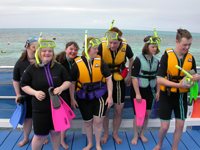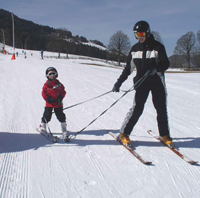Increasing opportunities for physical activity
Being physically active can have a number of benefits - having fun, meeting with friends, keeping healthy and experiencing success. For children with Down syndrome the foundations need to be laid early if they are to keep active in school, teenage and adult years and parents ask for more help in this area from professionals.
Buckley, S. (2007) Increasing opportunities for physical activity. Down Syndrome Research and Practice, 12(1), 18-19. doi:10.3104/updates.2033

"Physical activity can take many forms from enjoying a walk in the woods or the park, to playing in the garden or on the beach, to playing a competitive sport."
Physical activity can take many forms from enjoying a walk in the woods or the park, to playing in the garden or on the beach, to playing a competitive sport. Some physical activities need a partner (e.g. tennis, badminton, bowling) or a team of partners (e.g. cricket, football, baseball). Some can be enjoyed alone (e.g. yoga, swimming, running). Being physically active is usually enjoyable and also has health benefits. Most activities also bring social benefits.
Children's choices of physical and sporting activities are influence by their families, their peers and their schools. Since many of these activities take place outside school time, the enthusiasm and support of families can have a considerable influence on children's participation in them. This is true for all children, with or without disabilities. However, there may be additional barriers to be overcome if children with disabilities are to enjoy physical activities. This is the issue explored with families by Kristi Menear of the University of Alabama [1] in a study reported in this issue.
Parents of children with Down syndrome were invited to join small focus groups. Three of the groups were age-specific, the first involving families of preschoolers, the second families of elementary school age children and the third those with teenagers. The fourth mixed group included parents of children across this whole age range.
In the groups, parents were involved in group interviews which were audio-recorded and then transcribed in full. In the groups, families discussed the current physical activity levels of their children and their participation in active play, sports or dance. They also shared their views regarding the barriers that they felt existed now and that they will face in the future if they wish their child to be physically active.
There was much common ground in the views of the families. All recognised the health benefits associated with keeping active and were concerned about helping their children avoid later obesity. Most identified that their children were more motivated to be active when the activity was social and involved being with friends or brothers and sisters.
Families with preschool children with Down syndrome were satisfied that their children were active enough but worried that they would not be in years to come. Families with elementary age children felt that their children's activity levels were already waning and that it was becoming more difficult for them to keep up with their peers in sporting activities. Families with teenage children reported that their teenagers wanted to participate in more sports than they could. They wanted to be with friends and to belong to sports teams. Some observed that their teenagers did not want to engage in 'special' activities with adapted rules when offered the opportunity. They knew that rules were adapted and wished to continue in mainstream sports and activities yet were unable to compete with able bodied peers.
From elementary age, then, families felt that their children could be more active than they were but that this could only be achieved if families were able to give more time to finding the opportunities for them and then supporting them in the activity. Many said that they did not feel they had the time needed to help their child be as active as they would like them to be as well as manage their other family needs. They also said that they wished they had started providing more opportunities for their child to learn sporting skills earlier in their preschool years.
Overall, families felt that participation in sports had or would become more difficult for the child with Down syndrome as they became older, particularly involvement with team sports. One conclusion, therefore, was the need to encourage more individual sports - those which can be enjoyed alone or with others but do not need to involve competition. Swimming, going to the gym to work out, dancing and cycling are just some of many possibilities for individual or social enjoyment.
Parents wanted more assistance from physical activity professionals - for both home based and community based activities. This assistance could include individual advice on how to teach particular sports and how to keep children active. It should also include setting up more opportunities in the community that their children could participate in now and when they were adults. As parents reflected on the issues, they noted the benefits of encouraging active participation in sports from preschool years in order to build competence for later.

"There may still be a need to raise expectations of what young people with Down syndrome can achieve among parents, professionals and the wider community."
The findings reported in this article highlight the need for more attention to be paid to laying the foundations for a healthy lifestyle in the preschool years, recognising the benefits for both health, leisure time and for creating social opportunities in teenage and adult life. There is a message here for those working in early intervention and preschool education programmes. Support for the development of motor skills needs to extend beyond a focus on getting children walking and include programmes, advice and opportunities to help families to help their children to develop active play and sporting skills.
There may still be a need to raise expectations of what young people with Down syndrome can achieve among parents, professionals and the wider community. All motor activity only improves with the opportunity to learn and, most importantly, to practise. Many individual stories identify the high level of skills that can be achieved by young people with Down syndrome in a range of sports when given the opportunity. In the author's experience (see REF 2), most of these high achievers have had families interested in physical activities and sports, who have encouraged the young person with Down syndrome from an early age. Swimming is often encouraged from a very early age and full use made of community preschool gymnastics and dance groups before focusing on teaching particular skills such as skiing, football or cycling.
It is also important to remember that it is not necessary to aim at excellence or competence in particular sports when thinking about the health and social benefits of physical activity. The more important goal which will help everyone is to find ways to keep children and adults with Down syndrome active and on their feet rather than sedentary, ideally ways that can be enjoyed by other members of the family - who may also gain health benefits!
Sue Buckley is at Down Syndrome Education International, Portsmouth, Hampshire, UK.
doi:10.3104/updates.2033
References
- Menear KS. Parents' perceptions of health and physical activity needs of children with Down syndrome. Down Syndrome Research and Practice. 2007;12(1):60-68. [Read Online ]
- Sacks BI, Buckley SJ. Motor development for individuals with Down syndrome - An Overview. Portsmouth, UK: Down Syndrome Education International. 2003.

